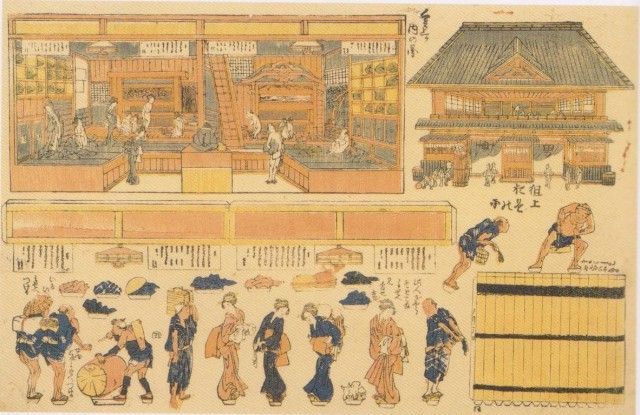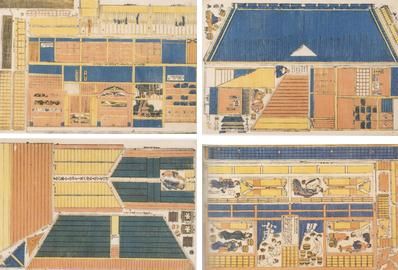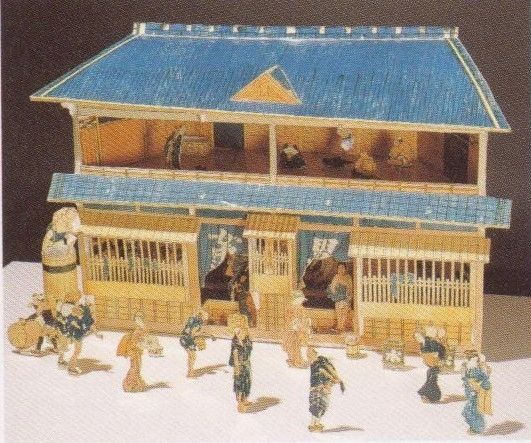Thanks to John Wagenseil, who posted this beautiful and rare find in Paper Modelers Forum, here is the Ancient Bath House In Japan, a 200 years old Tatebanko, originally posted at Live Journal website, now, at your fingertips, for free, for you to cut and assemble.
Graças à John Wagenseil, do Forum Paper Modelers, que postou este belo e raro achado, eis aqui a Casa de Banho Antiga, no Japão, um Tatebanko de 200 anos de idade, originalmente postado no site Live Journal, agora ao seu alcance, de graça, para você recortar e montar.
 "This set of five pictures of a bathhouse is of the type generally known as kumiage-e (in the Kansai area, tatebanko), designed to be cut out then folded and pasted together in accordance with the picture of the completed work so as to make a three-dimensional model. Such kumiage-e were a notoriously difficult genre for the average ukiyo-e artist, so much so that there were artists who specialized in it. The need for the artist to calculate as he painted the exact size for each section so that it would fit into the completed model, and the question of how to make the completed model, into a convincingly three-dimensional structure, posed a challenge to both the artist's technical ability and the accuracy of his work. Hokusai was considered a master in this field as elsewhere, the completed works made from his pictures achieving a splendidly calculated effect of three-dimensionality that far outstrips pieces by other artists. Here, for example, as the pictures of the madeup work show, the design of the interior is calculated to create an effect of deep perspective, while the same clever calculation has also gone into the street outside the building. The work is valuable and interesting for the light it throws on life in Edo. However, as with the other cut-out pictures, extremely few examples are extant; presumably the rest were used for the purpose for which they were intended. Moreover, since only a complete and unused set makes it possible to construct the model, any set such as this that survives complete is extremely valuable. The set is believed to have been published around 1810; all other similar works known to survive also date from around the same period." - Seiji Nagata: Hokusai. Genius of the Japanese Ukiyo-e. Tokyo / New York / London: Kadansha International, 1995
"This set of five pictures of a bathhouse is of the type generally known as kumiage-e (in the Kansai area, tatebanko), designed to be cut out then folded and pasted together in accordance with the picture of the completed work so as to make a three-dimensional model. Such kumiage-e were a notoriously difficult genre for the average ukiyo-e artist, so much so that there were artists who specialized in it. The need for the artist to calculate as he painted the exact size for each section so that it would fit into the completed model, and the question of how to make the completed model, into a convincingly three-dimensional structure, posed a challenge to both the artist's technical ability and the accuracy of his work. Hokusai was considered a master in this field as elsewhere, the completed works made from his pictures achieving a splendidly calculated effect of three-dimensionality that far outstrips pieces by other artists. Here, for example, as the pictures of the madeup work show, the design of the interior is calculated to create an effect of deep perspective, while the same clever calculation has also gone into the street outside the building. The work is valuable and interesting for the light it throws on life in Edo. However, as with the other cut-out pictures, extremely few examples are extant; presumably the rest were used for the purpose for which they were intended. Moreover, since only a complete and unused set makes it possible to construct the model, any set such as this that survives complete is extremely valuable. The set is believed to have been published around 1810; all other similar works known to survive also date from around the same period." - Seiji Nagata: Hokusai. Genius of the Japanese Ukiyo-e. Tokyo / New York / London: Kadansha International, 1995 "Este conjunto de cinco folhas de uma casa de banho é do tipo geralmente conhecido como Kumiage-e (na região de Kansai, Tatebanko), e é feito para para que as peças sejam cortadas, em seguida, dobradas e coladas em conjunto, de acordo com a imagem do trabalho concluído de modo a criar um modelo (diorama) tridimensional. Esse tipo de Kumiage-e / Tatebanko era um gênero notoriamente difícil para o artista comumem geral, tanto que havia artistas que se especializaram nisso. A necessidade do artista de calcular e desenhar o tamanho exato de cada seção para que ela se enquadre no modelo completo, é o grande desafio em se fazer uma estrutura tridimensional de forma convincente, que dasafia não só o lado artístico, mas também o lado matemático, devido a obrigatoriedade de lógica e precisão neste tipo de trabalho. Hokusai foi considerado um grande mestre nesse campo, como também em outras artes. Os modelos montados a partir de seus desenhos um efeito esplendidamente calculado de tridimensionalidade que supera de longe peças de outros artistas. Aqui, por exemplo, como se vê nas imagens, o desenho do interior é calculada para criar um efeito de perspectiva profunda, ao passo que o mesmo cálculo inteligente foi feito para a rua fora do edifício. O trabalho é valioso, pois dá um vislumbre de como era a vida em Edo há 200 anos atrás. Infelizmente, como a maioria destas delicadas formas de arte, pouquíssimos sobreviveram, presumivelmente porque a maioria foi utilizada para o fim a qual se destinavam. Além disso, uma vez que apenas um conjunto completo e sem uso torna possível construir o modelo, qualquer conjunto tal como este, que sobrevive intacto, é extremamente valioso. Acredita-se que esse modelo foi originalmente publicado em 1810, pois todas as outras obras semelhantes conhecidas que sobreviveram, são deste período." - Seiji Nagata: Hokusai. Genius of the Japanese Ukiyo-e. Tokyo / New York / London: Kadansha International, 1995
"Este conjunto de cinco folhas de uma casa de banho é do tipo geralmente conhecido como Kumiage-e (na região de Kansai, Tatebanko), e é feito para para que as peças sejam cortadas, em seguida, dobradas e coladas em conjunto, de acordo com a imagem do trabalho concluído de modo a criar um modelo (diorama) tridimensional. Esse tipo de Kumiage-e / Tatebanko era um gênero notoriamente difícil para o artista comumem geral, tanto que havia artistas que se especializaram nisso. A necessidade do artista de calcular e desenhar o tamanho exato de cada seção para que ela se enquadre no modelo completo, é o grande desafio em se fazer uma estrutura tridimensional de forma convincente, que dasafia não só o lado artístico, mas também o lado matemático, devido a obrigatoriedade de lógica e precisão neste tipo de trabalho. Hokusai foi considerado um grande mestre nesse campo, como também em outras artes. Os modelos montados a partir de seus desenhos um efeito esplendidamente calculado de tridimensionalidade que supera de longe peças de outros artistas. Aqui, por exemplo, como se vê nas imagens, o desenho do interior é calculada para criar um efeito de perspectiva profunda, ao passo que o mesmo cálculo inteligente foi feito para a rua fora do edifício. O trabalho é valioso, pois dá um vislumbre de como era a vida em Edo há 200 anos atrás. Infelizmente, como a maioria destas delicadas formas de arte, pouquíssimos sobreviveram, presumivelmente porque a maioria foi utilizada para o fim a qual se destinavam. Além disso, uma vez que apenas um conjunto completo e sem uso torna possível construir o modelo, qualquer conjunto tal como este, que sobrevive intacto, é extremamente valioso. Acredita-se que esse modelo foi originalmente publicado em 1810, pois todas as outras obras semelhantes conhecidas que sobreviveram, são deste período." - Seiji Nagata: Hokusai. Genius of the Japanese Ukiyo-e. Tokyo / New York / London: Kadansha International, 1995Link: Ancient.Bath.House.In.Japan.by.Live.Journal.via.Paper.Modelers
More Vintage Japanese Tatebankos related posts:
Utagawa Yoshufuji`s Tatebanko - by Patrick Pasques
Vintage Japanese Tatebanko - by John Wagenseil - via Paper Modelers - Tatebanko Japonês
Dance Of The Gods At The Heavenly Cave Tatebanko - by Toto
Paper Model History - 1873`s Japanese Tatebanko - by University Of Tsukuba Library



only too well the links to the tatebanko pages seem to be dead
ReplyDeleteHello, just click with the right boton and choose: save link as...
DeleteThis way you can save the dead ones.
On right clicking on the images of site it saves only some empty "download.html" without any images and/or pdf.
DeleteLivejournal says "Empty album. This album has no photos."
Do I make some error?
...and Wayback machines hasn't any copy.
Have you some other indications